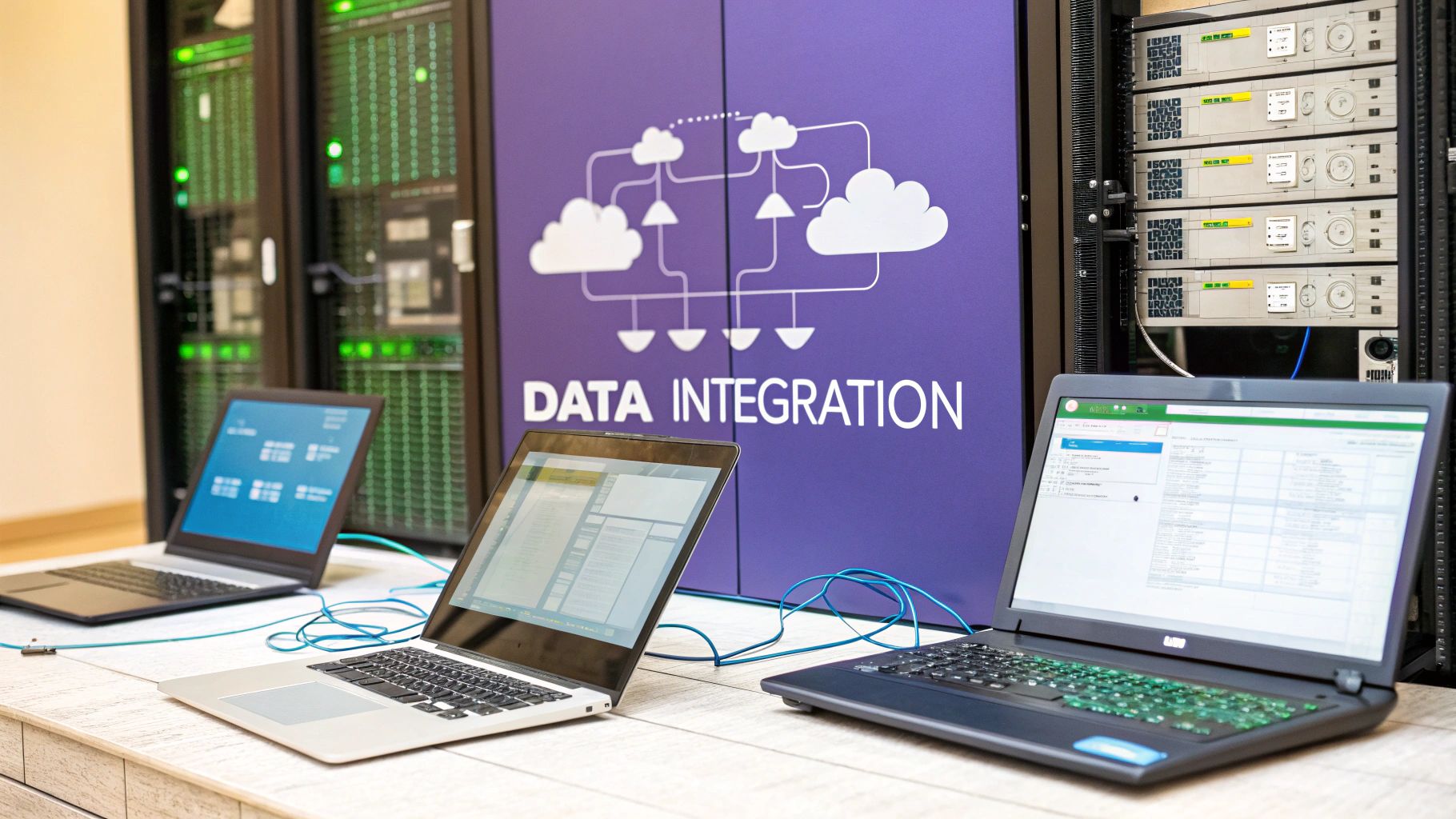
In today's competitive environment, data isn't just a byproduct of business operations; it's the fuel for growth, innovation, and superior customer satisfaction. However, with information scattered across countless SaaS applications, CRMs, support desks, and usage platforms, teams often struggle to get a clear, unified view of their customers and operations. This data fragmentation leads to missed opportunities for Customer Success teams and creates significant challenges for IT professionals tasked with maintaining a coherent tech stack.
Effective data integration software bridges these critical gaps, transforming siloed information into a strategic, actionable asset. A core objective of a unified data strategy is to enhance operational efficiency. To further explore methods for achieving this, consider how to streamline business processes across your organization. This guide is designed to help you find the right tool for that purpose.
This article provides an in-depth review of the 12 best data integration software tools available today. We'll move beyond generic feature lists to offer a practical guide for Customer Success Managers and IT leaders, focusing on real-world use cases, implementation hurdles, and the honest limitations of each platform. Each review includes detailed analysis, screenshots, and direct links to help you make an informed decision. Whether you need to automate complex workflows, achieve a 360-degree customer view, or consolidate your entire data ecosystem, this resource will help you select the right tool to turn data chaos into a competitive advantage.
Best for AI-Powered Customer Success Data Integration
Statisfy emerges as a premier choice in the data integration software landscape, uniquely positioning itself as an AI-driven copilot for Customer Success (CS) teams. It excels at unifying fragmented customer data from disparate sources like CRMs, communication platforms, and product usage logs. The platform’s core strength lies in its ability to not just aggregate this data but to transform it into proactive, actionable strategies that directly influence customer retention and growth.
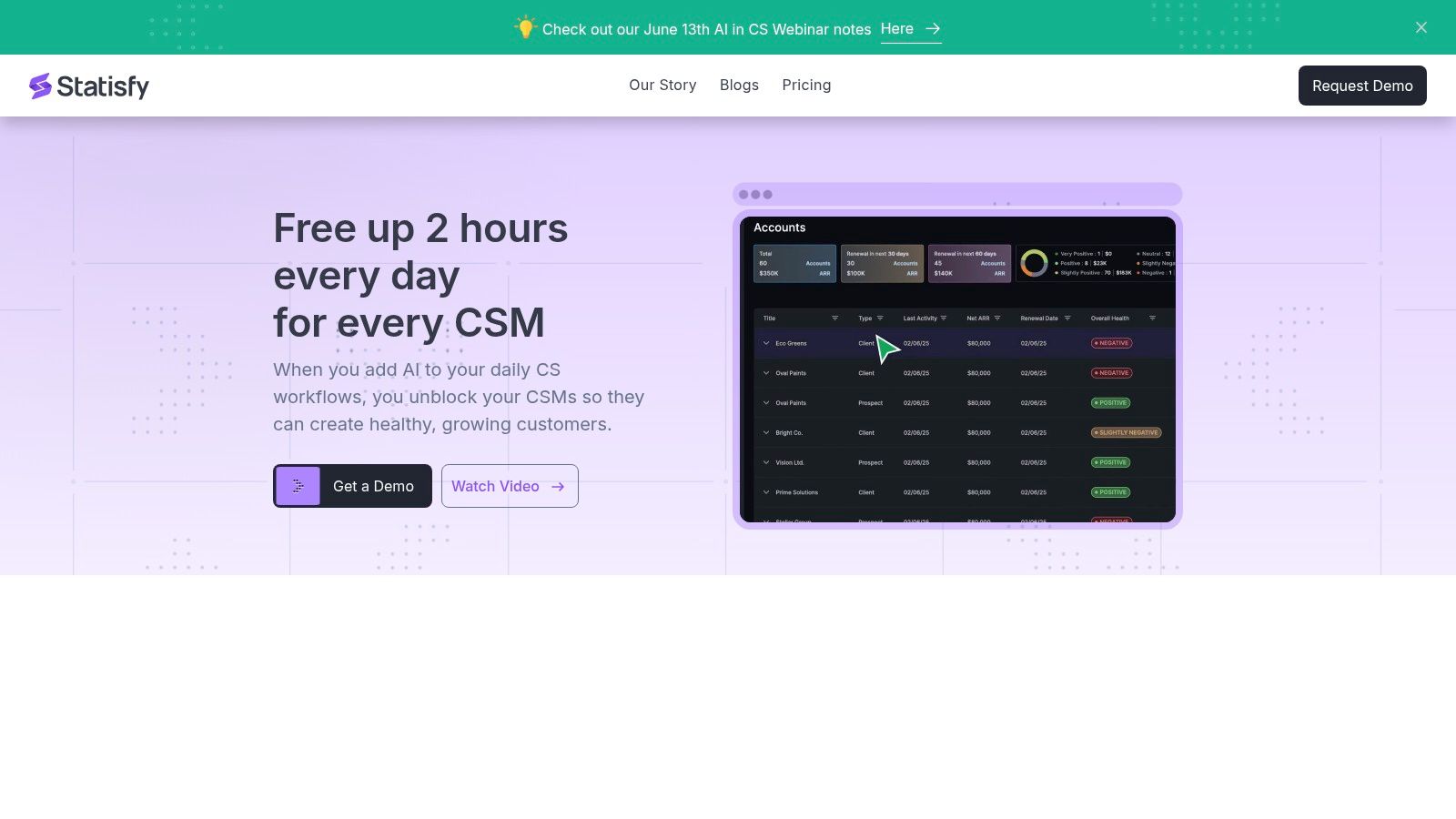
Unlike traditional tools that simply pipe data from one system to another, Statisfy’s generative AI and advanced LLMs analyze the integrated information to provide contextual insights. This empowers Customer Success Managers (CSMs) to move beyond reactive problem-solving and engage customers with foresight, a critical advantage for any business focused on maximizing lifetime value.
Statisfy's architecture is built around a suite of intelligent agents that automate and streamline workflows, making it a standout solution for data integration software focused on the customer lifecycle.
Organizations like Cerby and Observe.ai leverage Statisfy to automate time-consuming manual tasks, freeing up an average of two hours per CSM daily. This reclaimed time is reinvested into high-value strategic activities, such as building stronger customer relationships and identifying expansion opportunities. The rapid onboarding process, which gets teams operational in weeks rather than months, is a significant practical benefit, minimizing downtime and accelerating the time-to-value.
For teams looking to get started, the best approach is to identify a primary pain point, such as inaccurate customer health scoring or manual meeting preparation, and use Statisfy to address it first. The platform's modular design allows for a phased implementation, ensuring user adoption and demonstrating measurable ROI quickly.
Pricing: Pricing is not publicly listed. You must contact the Statisfy team to request a demo and receive a custom quote tailored to your organization's needs.
Pros & Cons:
Website: https://www.statisfy.com
Integrate.io positions itself as a powerful, low-code data integration platform designed for the modern data stack. It excels at unifying ETL, ELT, Reverse ETL, and data observability into a single, cohesive interface. This approach makes it a strong contender for teams seeking robust data integration software without the steep learning curve often associated with more developer-centric tools. The platform's visual, drag-and-drop workflow empowers business users, like Customer Success Managers, to build their own data pipelines, freeing up valuable IT resources.
What sets Integrate.io apart is its commitment to accessibility and comprehensive support. With over 200 native connectors, it can easily pull data from CRMs, databases, and marketing automation tools into a central warehouse. The platform's Reverse ETL capabilities are particularly useful for Customer Success teams, allowing them to push enriched data from the warehouse back into operational tools like Salesforce or Zendesk, providing a 360-degree customer view directly within their daily workflows.
Integrate.io’s pricing is connector-based, which can be a double-edged sword. While this model provides predictability, it may become costly for organizations that require a vast number of different integrations.
Learn more at Integrate.io.
Jitterbit positions itself as a versatile API integration platform designed to rapidly connect SaaS, on-premise, and cloud applications. It focuses on empowering businesses to automate workflows and deliver integrated experiences through a low-code environment. This makes it a compelling piece of data integration software for companies looking to accelerate their digital transformation without extensive coding. The platform is particularly noted for its use of pre-built templates and recipes, which can significantly speed up the initial setup of common integration patterns.
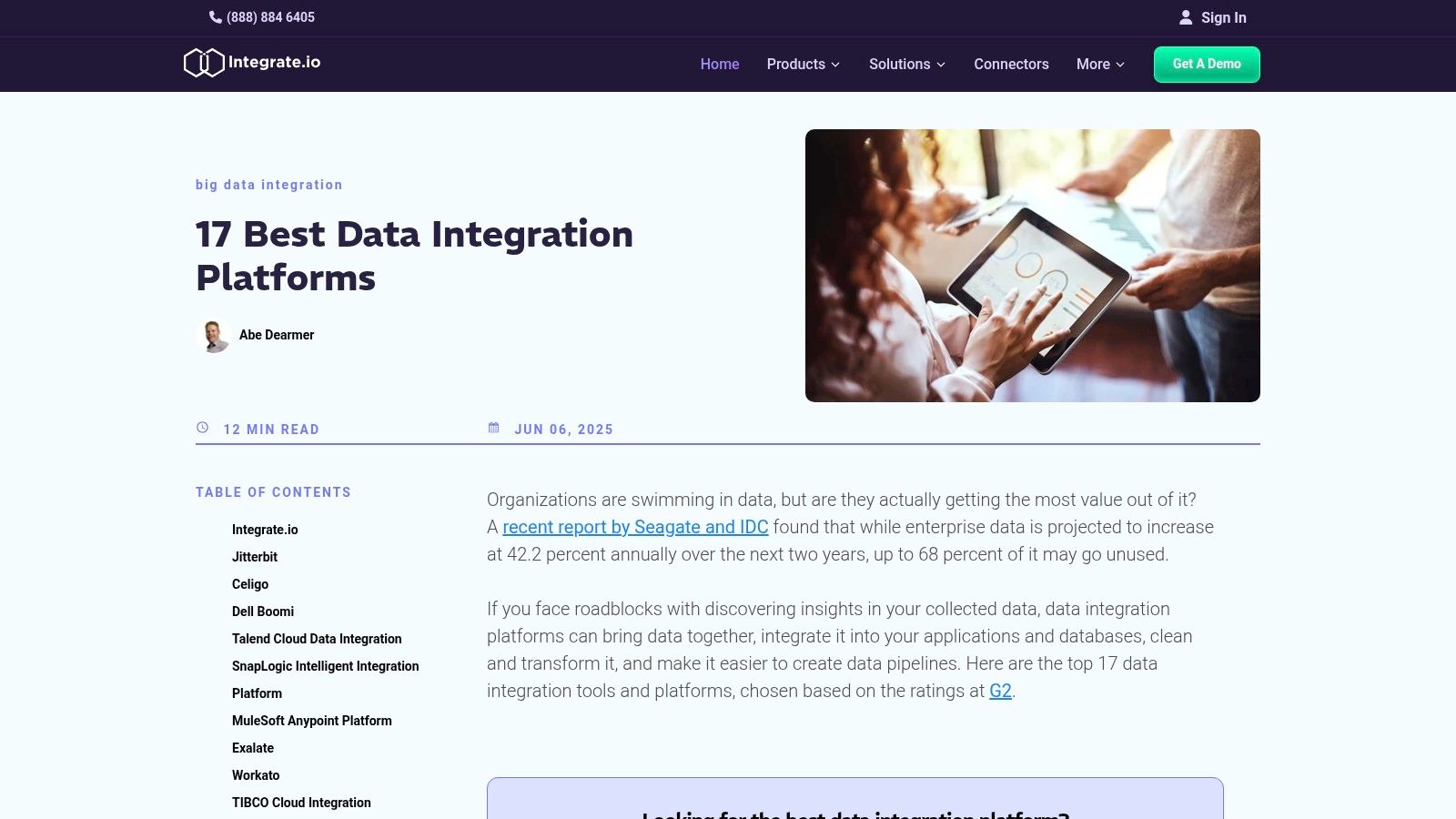
What makes Jitterbit stand out is its robust API creation and management capabilities combined with AI-powered features. Users can not only connect existing systems but also create and expose new APIs, transforming core business processes into reusable services. For Customer Success teams, this means easier access to unified data from disparate sources like ERPs and CRMs. The AI-powered services, such as real-time language translation or speech recognition, add a unique layer of functionality, enabling more innovative and intelligent data-driven workflows.
While Jitterbit offers a powerful and scalable solution, users have noted that its more advanced features can present a learning curve. Furthermore, when dealing with highly complex or large-volume ETL processes, performance can sometimes be a consideration compared to more specialized data-moving tools.
Learn more at Jitterbit.
Talend Data Fabric is a comprehensive suite that unifies data integration, data quality, and data governance into a single, low-code platform. It is engineered to help organizations automate cloud data pipelines, providing a trusted foundation for faster, more reliable business intelligence. As a versatile piece of data integration software, Talend empowers both technical developers and business analysts to collaborate on building and managing complex data workflows, ensuring data is clean, compliant, and readily accessible across the enterprise.
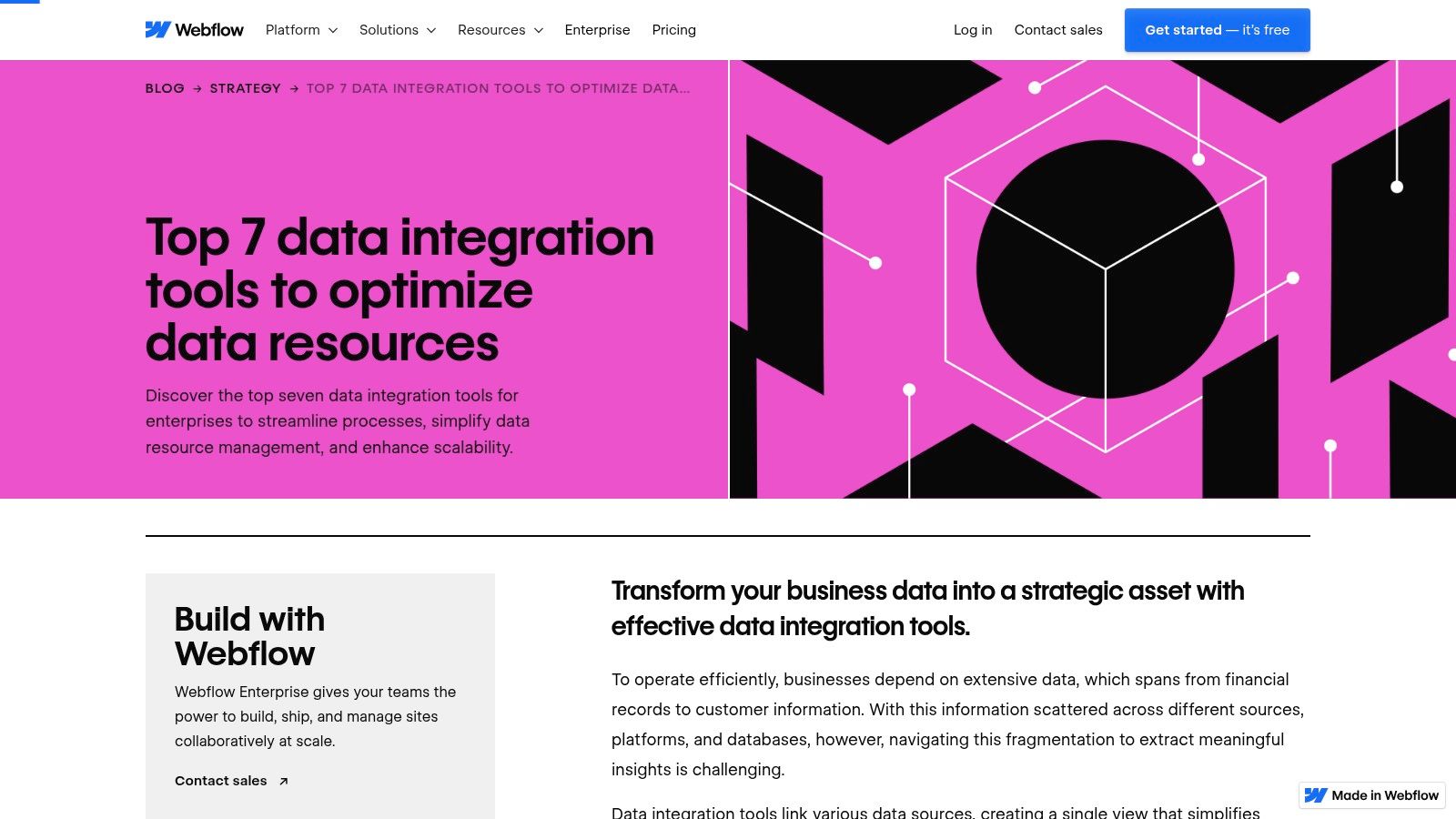
What distinguishes Talend is its sheer breadth of connectivity and its unified approach to the entire data lifecycle. With over 1,000 connectors and components, it can connect to virtually any data source or cloud platform. This flexibility is crucial for Customer Success teams needing to pull disparate data from CRMs, ERPs, and support systems to create a holistic customer profile. The platform’s integrated data quality tools allow teams to profile, cleanse, and standardize data within the same environment, which is essential for trusting the insights derived from analytics.
Talend offers a free, open-source version called Talend Open Studio, which is a great entry point. However, the more advanced features for collaboration, governance, and real-time integration are reserved for its paid commercial editions.
Learn more at Talend.
SnapLogic provides an intelligent Integration Platform as a Service (iPaaS) that excels at connecting cloud and on-premises applications and data sources. It distinguishes itself through an AI-powered, low-code interface designed for both IT professionals and business users. This dual focus makes it a versatile piece of data integration software for organizations looking to democratize data access and automate workflows across disparate systems. The platform's core strength lies in its ability to handle application, API, and data integration within a single, unified environment.

What makes SnapLogic stand out is its AI assistant, Iris AI, which offers real-time guidance to speed up the development of integration pipelines. With an extensive library of over 500 pre-built connectors, called "Snaps," users can quickly build data pipelines for ETL, ELT, and real-time processing. This is particularly valuable for Customer Success teams needing to consolidate data from various customer touchpoints, like a CRM and a support desk, into a single source of truth for a comprehensive customer view.
SnapLogic’s approach is geared towards enterprise-level scalability, allowing organizations to manage complex integration needs as they grow. However, its broad functionality might be more than what a small business requires, and the platform’s pricing reflects its enterprise focus.
Learn more at SnapLogic.
Boomi offers a comprehensive, cloud-native integration Platform as a Service (iPaaS) that excels in connecting applications and automating workflows across complex, hybrid cloud environments. It is renowned for its low-code, drag-and-drop interface, which makes it accessible for both business analysts and IT professionals. As a veteran in the space, Boomi has developed a robust platform that goes beyond simple data movement, incorporating API management, master data management, and workflow automation into a single unified solution, making it a powerful piece of data integration software.

What distinguishes Boomi is its extensive library of over 1,500 connectors and its "Boomi Atom" architecture. This lightweight, dynamic runtime engine can be deployed in the cloud or on-premises, providing flexibility for organizations with strict data governance or legacy systems. For Customer Success teams, this means Boomi can unify data from virtually any source, from cloud CRMs to on-premise ERPs, creating a complete customer profile. The platform supports both real-time and batch processing, ensuring that insights are timely and relevant.
Boomi's all-in-one approach simplifies the tech stack by bundling multiple integration-related capabilities. However, while the basic interface is intuitive, mastering its more advanced features, like complex process logic and API design, can present a notable learning curve for new users.
Learn more at Boomi.
Informatica's Intelligent Data Management Cloud (IDMC) is a heavyweight in the enterprise data landscape, offering a comprehensive, AI-powered platform for managing complex data ecosystems. It is engineered to handle large-scale data integration, quality, governance, and API management across multi-cloud and on-premises environments. This makes it a go-to choice for large organizations needing a single, unified solution for their entire data integration software strategy, from ingestion to consumption.
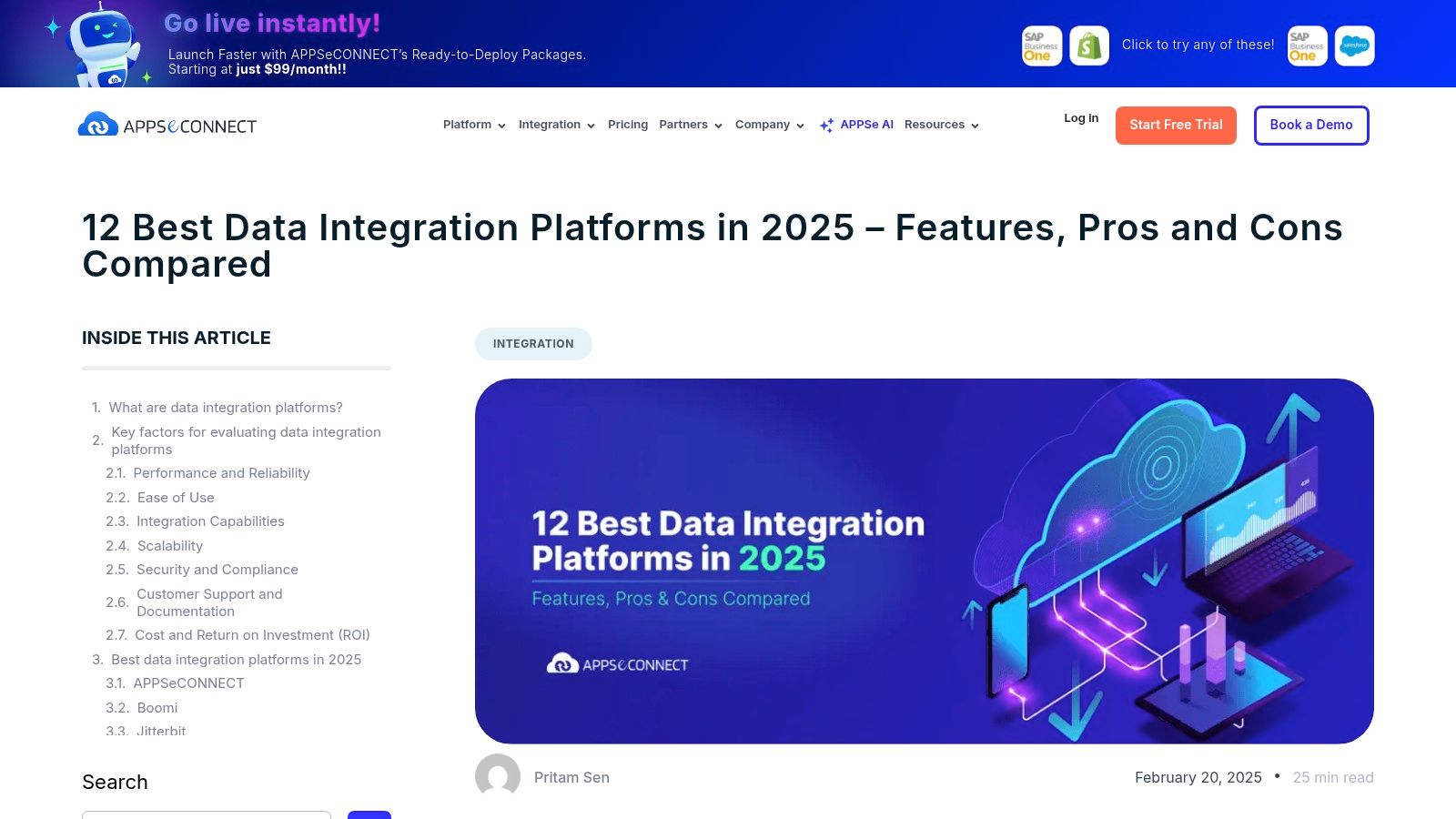
What sets Informatica apart is its sheer breadth and depth of capabilities, consolidated into one platform. Its AI-powered automation, known as CLAIRE, assists with tasks like metadata management and data discovery, which can significantly accelerate development and improve data governance. For Customer Success teams, this means having access to highly trusted, quality-controlled data from various sources, enabling more accurate health scoring and churn prediction models. The platform’s advanced scheduling and monitoring tools ensure that these critical data pipelines are reliable and performant.
Informatica’s strength lies in its enterprise-grade scalability and robust feature set, designed to meet stringent security and compliance requirements. However, this level of sophistication comes with a steeper learning curve and a pricing structure that may not be suitable for smaller businesses.
Learn more at Informatica.
MuleSoft Anypoint Platform, acquired by Salesforce, is an enterprise-grade solution that shines in its API-led approach to connectivity. It treats every data source, application, and device as a modern, reusable API, enabling organizations to build a flexible application network. This makes it a powerhouse for complex environments that need to integrate legacy systems with modern cloud services. As a piece of data integration software, its strength lies in creating a unified, governable, and scalable framework for all data flows across the enterprise, supporting cloud, on-premise, and hybrid deployments.
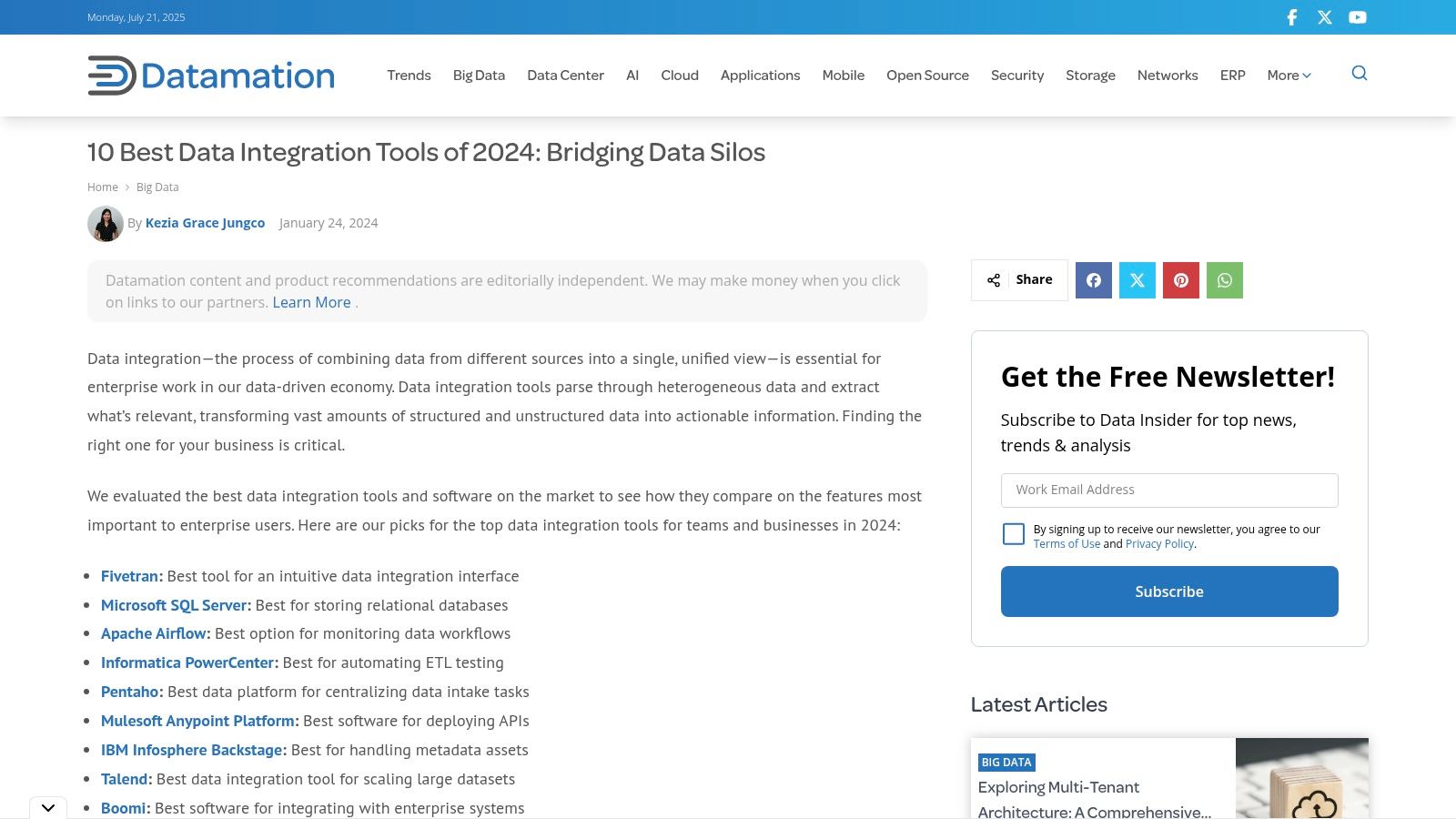
What truly distinguishes MuleSoft is its comprehensive lifecycle management for APIs, from design and development to security and governance. For Customer Success teams, this means that the critical data they need from various systems can be accessed through stable, well-managed APIs. This ensures reliable data delivery to CRMs and other tools, providing a consistent 360-degree customer view. Its extensive library of connectors and templates helps accelerate integration projects that might otherwise be highly complex.
MuleSoft is a robust, developer-centric platform, which means it requires significant technical expertise and can be resource-intensive to manage effectively. Its pricing structure is often ambiguous and tailored to large-scale enterprise needs, making it less accessible for smaller organizations.
Learn more at MuleSoft Anypoint Platform.
Fivetran is a market leader in automated data movement, championing a modern, ELT (Extract, Load, Transform) approach. It stands out for its simplicity and reliability, offering a fully managed service that allows teams to centralize data without writing or maintaining complex pipelines. This focus makes it an excellent choice for organizations looking to quickly stand up a robust data integration software framework and free up engineering resources to focus on generating insights rather than managing infrastructure.

What truly differentiates Fivetran is its vast library of over 400 pre-built, fully-managed connectors that are maintained and updated by Fivetran engineers. This "set it and forget it" model means that when a source API changes, Fivetran handles the update, ensuring data flows remain uninterrupted. The platform automatically manages schema changes, adapting to new columns or data types from the source and propagating them to the destination warehouse, which is a significant advantage for agile teams.
Fivetran’s pricing model is based on monthly active rows (MAR), which means you only pay for the unique data that is added or changed each month. While this is transparent, it can lead to unpredictable costs if source data volumes fluctuate significantly.
Learn more at Fivetran.
Qlik distinguishes itself by blending powerful data integration software with advanced, AI-powered analytics. It provides an end-to-end solution that automates the entire data pipeline, from raw data ingestion to creating actionable, visualized insights. The platform is built around its unique associative engine, which allows users to explore data freely in any direction without the constraints of predefined, query-based hierarchies. This makes it a formidable tool for teams that need to uncover hidden relationships and insights within their complex datasets.
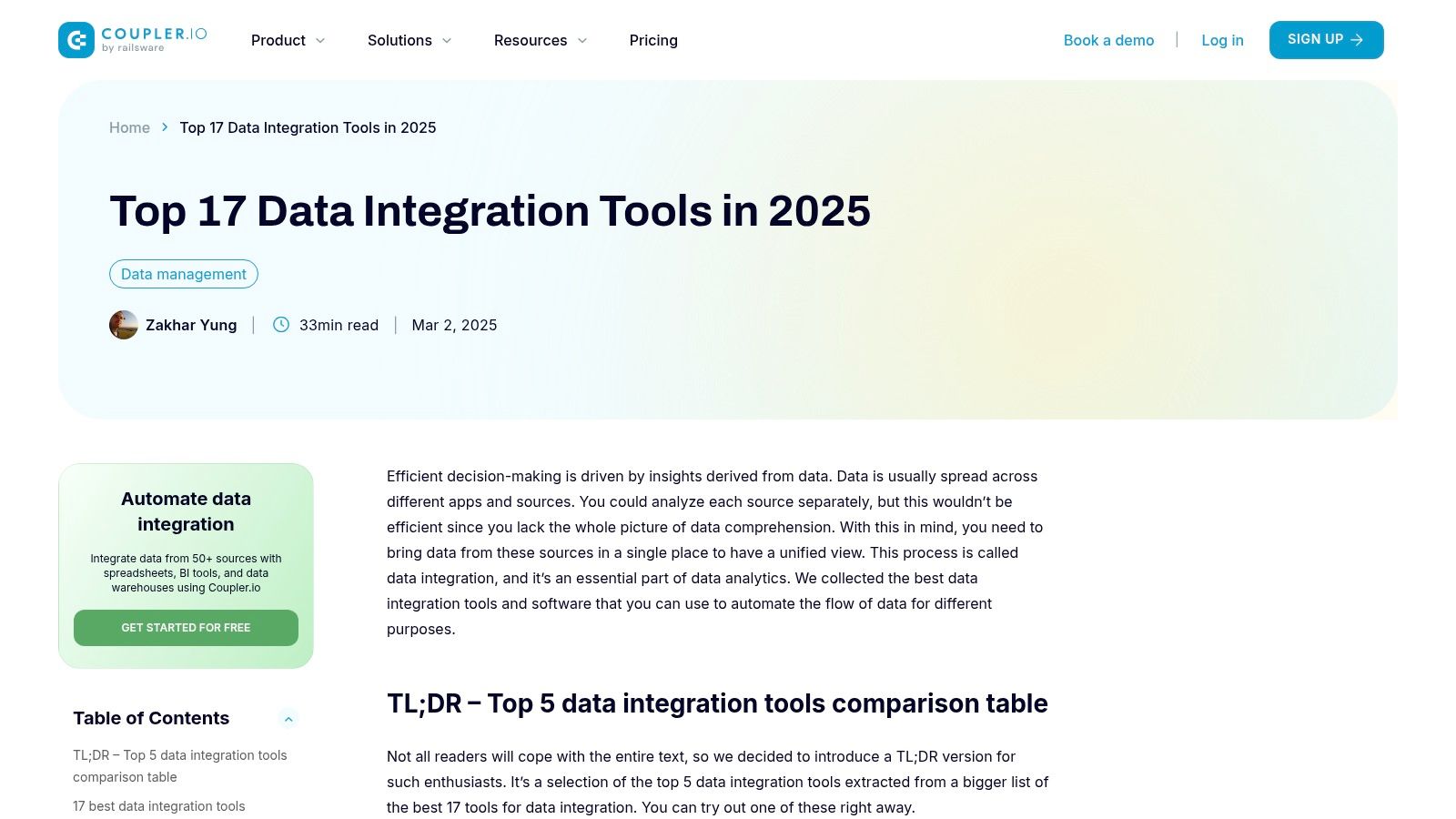
What makes Qlik particularly effective is its combination of robust, real-time data integration with an intuitive, drag-and-drop visualization builder. This dual capability empowers both IT professionals handling complex data pipelines and business users, like Customer Success Managers, who need to build dashboards and analyze customer health scores without writing code. The platform's ability to create a clean, analytics-ready data foundation is crucial for delivering trustworthy insights back to operational systems.
While Qlik is exceptionally powerful and scalable for enterprise use, its comprehensive feature set can introduce a learning curve for teams looking to leverage its more advanced analytical capabilities. The pricing structure can also be a significant factor for smaller organizations.
Learn more at Qlik.
IBM App Connect provides an enterprise-grade integration platform as a service (iPaaS) that excels at connecting applications and data across hybrid cloud environments. It is designed for businesses that need to orchestrate complex workflows between on-premises systems, like legacy databases, and modern SaaS applications. This makes it a robust piece of data integration software for large organizations looking to modernize their infrastructure without abandoning existing investments. The platform offers a user-friendly, configuration-based approach to building integration flows, which can appeal to both IT professionals and savvy business users.
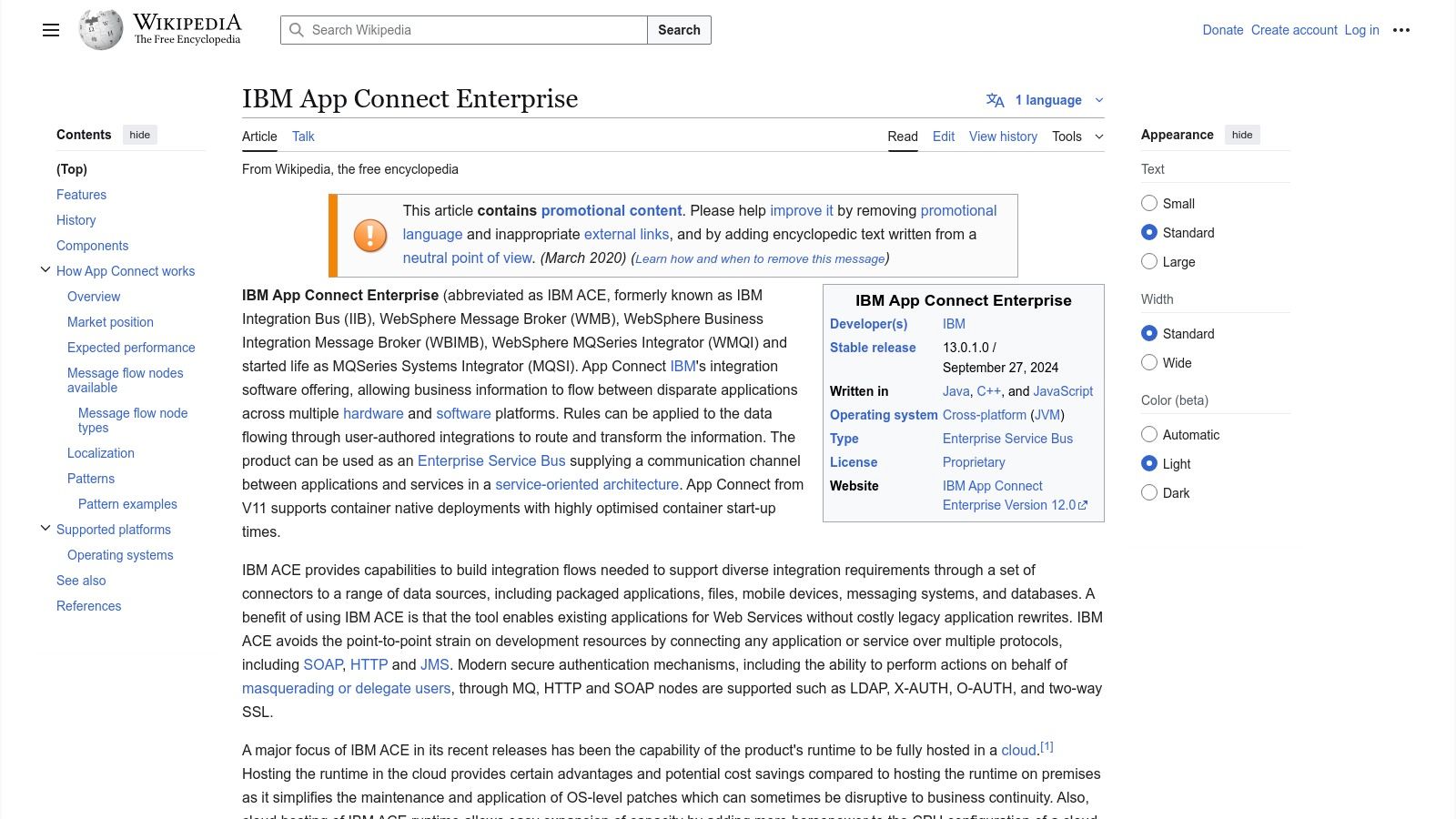
What sets IBM App Connect apart is its heritage and focus on enterprise-level needs. It supports a vast array of industry-standard data formats and protocols, ensuring compatibility with a wide range of enterprise systems. For Customer Success teams, this means it can reliably connect a central data warehouse with both modern CRMs like Salesforce and older, on-premises customer databases. Its advanced scheduling and monitoring tools provide the reliability and visibility required for managing business-critical data flows, ensuring customer data is consistently synced and up-to-date across all connected platforms.
While powerful, the platform’s extensive capabilities can introduce a learning curve for teams new to enterprise integration tools. Pricing is also geared more towards large-scale deployments rather than small businesses.
Learn more at IBM App Connect.
Pentaho, a part of Hitachi Vantara's portfolio, offers a comprehensive data platform that combines data integration with business analytics. It is a robust, enterprise-grade solution that provides ETL capabilities, OLAP services, reporting, and data mining within a single environment. This makes it a powerful piece of data integration software for organizations that need to manage the entire data lifecycle, from raw data ingestion and transformation to final business intelligence and visualization.
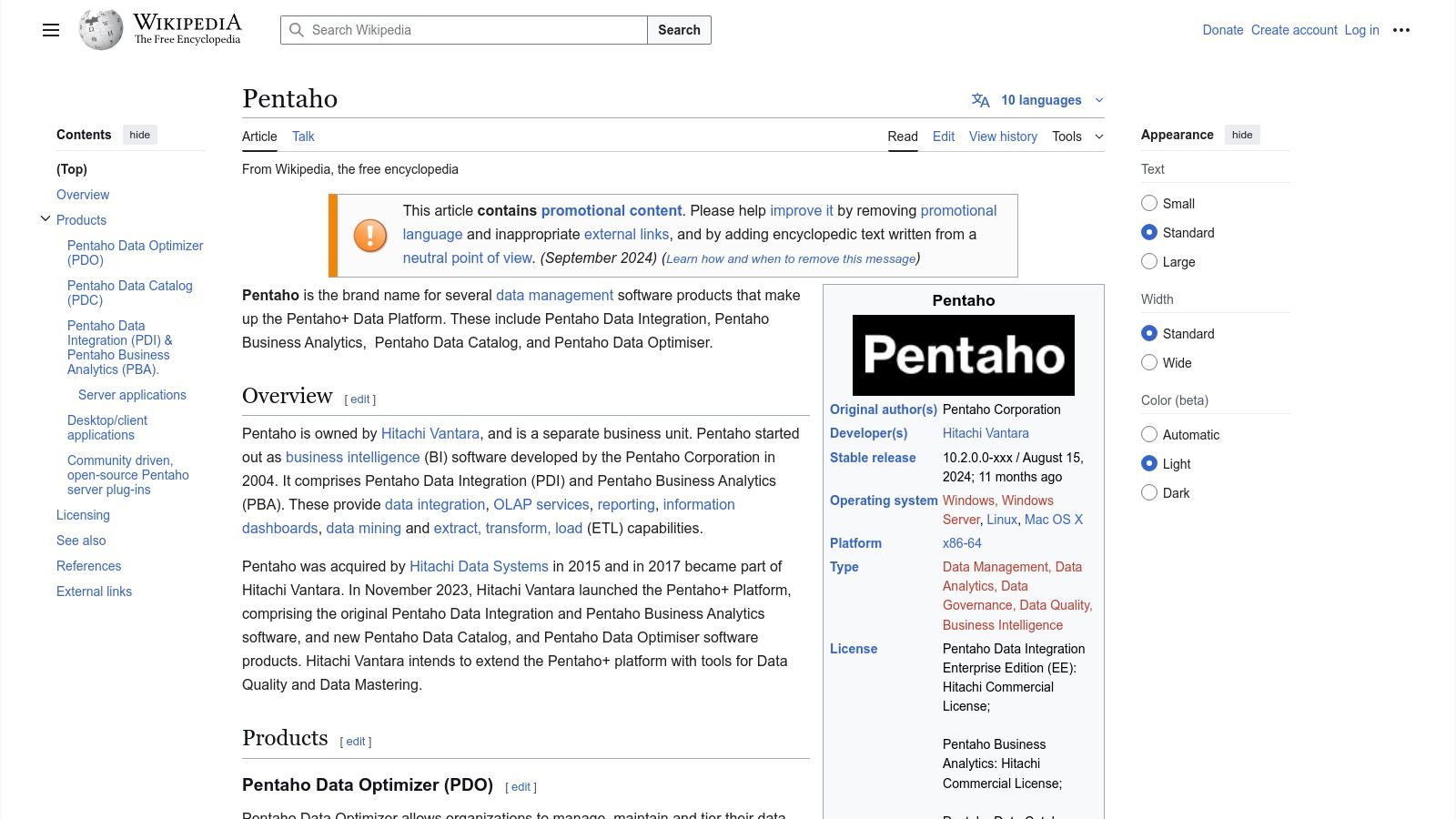
What distinguishes Pentaho is its flexibility and open-source foundation. While there is a commercial enterprise edition, the free community edition provides significant power, making it accessible for teams to start experimenting. For Customer Success teams, this means they can leverage its ETL tool, Kettle (Spoon), to build complex data transformation workflows that unify customer data from disparate sources like databases, flat files, and APIs. The platform’s ability to handle large data volumes and its scheduling tools make it suitable for automating critical data pipelines that feed into customer analytics dashboards.
Pentaho’s strength lies in its all-in-one approach, but this can also introduce complexity. The platform has a steeper learning curve compared to modern low-code tools, requiring more technical expertise to fully utilize its advanced features.
Learn more at Pentaho.
Selecting the right data integration software is a pivotal decision, one that extends far beyond the IT department to influence daily operations, customer relationships, and long-term strategic planning. This guide has navigated the diverse landscape of available tools, showcasing how each platform addresses unique business challenges. The journey from raw data to actionable insight is complex, but the right partner can transform it into a seamless and value-driven process.
We've seen that the market doesn't offer a one-size-fits-all solution. Instead, it presents a spectrum of specialized tools. For large enterprises with deep technical resources, platforms like MuleSoft Anypoint Platform or Informatica PowerCenter provide robust, highly customizable frameworks capable of managing vast and intricate data ecosystems. In contrast, teams seeking agility and ease of use will find powerful allies in no-code or low-code solutions like Integrate.io and Fivetran, which excel at rapidly building and automating data pipelines without requiring extensive development cycles.
Your ideal tool is not necessarily the one with the most features, but the one whose features align perfectly with your organization's specific context. Before making a final decision, your team must have a clear, honest conversation about your needs.
Key questions to ask include:
A successful implementation hinges on more than just technical capabilities. As you evaluate your shortlist, consider the holistic partnership you are forming with the vendor. A key consideration when choosing a data integration partner is their expertise in areas like CRM integration with Facebook, enabling a seamless flow of customer data from critical social channels directly into your central systems. This level of specialized connectivity can be a significant differentiator.
Take full advantage of free trials and personalized demos. During this evaluation phase, pay close attention to the user experience, the quality of the documentation, and the responsiveness of their customer support team. The best data integration software will feel less like a tool you've purchased and more like an extension of your own team, empowering you to unlock the full potential of your data. For Customer Success teams, the ultimate goal isn't just to connect systems; it's to create a unified customer view that drives proactive engagement, reduces churn, and identifies new revenue opportunities. The platforms that facilitate this transformation, like Statisfy with its AI-driven insights, represent the true future of this technology, turning a necessary IT function into a strategic business asset.
Ready to move beyond simple data connections and start driving real business outcomes? Statisfy offers a next-generation approach to data integration software, specifically designed for Customer Success. We don't just move your data; we interpret it, using AI to deliver proactive insights that help you reduce churn and grow revenue. Discover how Statisfy can transform your customer data into your most valuable asset.